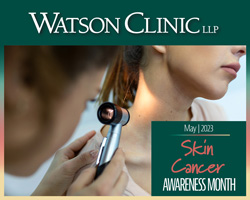 It's hard to believe that the welcoming Florida sunshine could prove dangerous, but it's a fact: The sun's ultraviolet (UV) rays are one of the major causes of skin cancer.
It's hard to believe that the welcoming Florida sunshine could prove dangerous, but it's a fact: The sun's ultraviolet (UV) rays are one of the major causes of skin cancer.
According to the Centers for Disease Control and Prevention, nearly 5 million people are treated for skin cancer every year in the United States.
Fortunately, most incidents of skin cancer can be prevented. That’s why it's crucial that you and everyone in your family—from infants to grandparents—take steps to protect themselves.
The outermost layer of your skin contains a protective pigment called melanin. The production of melanin increases when your skin is exposed to the sun; it’s responsible for the darkening of your skin. Tanning is the first sign of skin damage.
Too much sun exposure can allow destructive UV rays to penetrate the inner layers of your skin. This results in sunburn, destroys healthy skin cells, and places you at risk for developing skin cancer.
Excessive sun exposure can also lead to:
Freckles and moles. These can eventually turn into skin cancer.
Premature aging. As evidenced by wrinkled, tight or leathery skin, and dark spots.
Weakened immune system. When your skin gets burned, white blood cells rush to the area to repair the damage, weakening the immune response to other areas of your body.
Eye damage. Exposure to UV rays can lead to cataracts and blindness later in life.
Here are steps you should take to protect you and your family from these risks:
Seek shade. This is especially important during the sun’s peak hours between 10 a.m. and 2 p.m.
Wear protective clothes and sunglasses. Wear a lightweight, long-sleeved shirt, long pants, and a wide-brimmed hat if you plan to spend much time in the sun. Wear sunglasses that offer UV protection.
Lather up. Look for a sunscreen with broad-spectrum—UVA and UVB—protection. Generously apply it to all areas of your body that aren't protected by clothing. Choose a sunscreen with an SPF (sun protection factor) of at least 30. Reapply every two hours and after swimming or sweating.
Be extra careful near water, sand or snow. All three reflect sunlight and can raise your risk for sunburn.
Avoid tanning beds. Their UV light are not a safe alternative to the sun.
Check your skin regularly for sun damage. Schedule an appointment with your dermatologist if you notice any new or suspicious spots, especially if you observe these spots changing, itching or bleeding.
Know your personal sun sensitivity. Oral contraceptives, antibiotics, some pain medicines like ibuprofen and naproxen, and other medications can result in added sensitivity to sunlight. Be extra cautious if you're taking a medicine that increases these risks.
Some members of your family may be particularly vulnerable to getting burned, including:
Infants. Babies younger than 6 months should never be exposed to the sun's rays, and should be kept in the shade as much as possible. Dress them in long sleeves, long pants, a wide-brimmed hat and sunglasses. Make sure they get plenty of fluids, and don’t become dehydrated. Take your baby inside if they develop any redness on exposed skin.
Sunscreen should not be applied to babies 6 months or younger. For older babies and toddlers, use a broad-spectrum, water-resistant sunscreen with an SPF of 30 or higher. You may want to look for sunscreen made especially for this age group.
Children. You should take care to reapply sunscreen on your child’s exposed skin every two hours or after they've been swimming or sweating. A single blistering sunburn during childhood or adolescence may double their chances of developing melanoma later in life.
Teens and young adults. This age group may be most likely to engage in indoor tanning. Impress upon your teen the dangers of both indoor and outdoor tanning. Explain to them that even a so-called base tan is a sign of skin damage. Teach them that UV exposure adds up over time, and every time they tan it increases their chances of getting skin cancer. Urge them to cover up, use sunscreen and stay away from tanning beds.
Men. Men are more likely than anyone else to get skin cancer, including melanoma, which is the deadliest form of skin cancer.
Why are men at higher risk? They tend to spend more time outdoors than women, and they're more likely to work outdoors. They're also less likely to wear sunscreen: The CDC estimates that only 14% of men use sunscreen on both their face and other exposed areas of skin. Men should take the same basic sun-safety precautions when outdoors as everyone else.
Older adults. The CDC also reports that fewer than half of older adults take steps to protect their skin from the sun's rays when outside for at least an hour. That's despite the fact that most cases of skin cancer are found in people older than 65.
If you're an older adult, don't forget to use sunscreen when going outdoors, and practice the other basic sun-safety precautions listed above.
Maintaining regular appointments with a Watson Clinic Dermatology specialist is essential to staying safe and healthy in the Florida sun. Visit WatsonClinic.com/Dermatology for locations and appointment numbers.